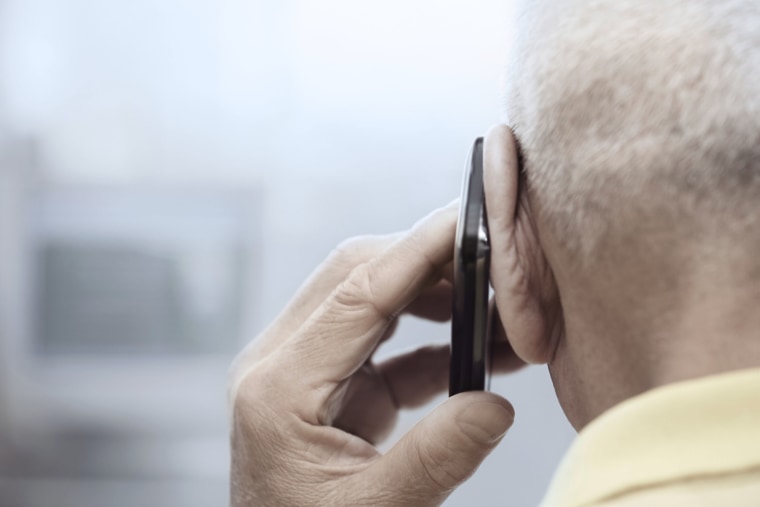The federal government’s National Toxicology Program released its final report Thursday on whether cellphones cause cancer. The final verdict: cellphone radiation may sometimes cause tumors in rats at high, continuous doses, but not in people.
The report leaves open the possibility that the kind of radiation produced by cellphones might have the potential to cause cancer, but it does not answer the question of how that might happen. The findings are unlikely to satisfy many people.
"The National Toxicology Program concluded there is clear evidence that male rats exposed to high levels of radio frequency radiation like that used in 2G and 3G cell phones developed cancerous heart tumors," the National Institutes of Health, parent agency of the NTP, said in a statement.
The final report doesn’t change much that the researchers said in a preliminary report released in February. It found there is evidence that bathing rats in certain types of cellphone radiation for their entire lives might raise the risk of certain cancers in some of the rats.
The findings do not apply to people, they said.
“The exposures used in our studies are not directly comparable to the exposures that humans typically experience when using a cellphone,” the National Toxicology Program’s John Bucher told reporters.
The NTP team did not expose the rats to the 4G frequencies now in common use.
The NTP gave its February report to experts for review, and Thursday’s report reflects their comments. In general, Bucher said, they advised the NTP to strengthen its confidence in what was found.
The two most significant findings: Male rats bombarded with high doses of cellphone radiation had a higher risk of a type of rare cancer called a schwannoma in the nerves surrounding the heart. In February, the NTP said there was some evidence this happened but now says the evidence is clear.
And they said there was now equivocal, or unclear, evidence that some female rats may develop similar tumors.
"In the brain of males, there were increased incidences of malignant glioma," the report added.
In a seeming contradiction, male rats exposed to cellphone signals lived longer than rats not exposed. They were especially less prone to a type of inflammatory kidney disease.
It’s still not clear why either thing might happen. The type of radiation that comes from cellphones is very different from the radiation that comes from gamma rays or nuclear energy. It can make tissue warm, but the rats were not given high enough doses to warm their tissues.
“We saw evidence of DNA damage in some tissue of some animals,” Bucher said. This will help guide scientists in targeting their future research.
Rat studies often find cancer links that never show up in people. And mice were not as strongly affected as rats seemed to be.
“We do believe that the tumor responses that we have seen in our studies is real and they are associated with radiofrequency radiation,” Bucher said.
But the bottom line of the report is that people should not worry that they will get cancer from using their cellphones.
“Exposure to radiofrequency radiation has long been thought to be of no health concern as long as the energy level was low and didn’t cause heating of the tissues,” Bucher said.
“Based on our results, we are planning further studies to confirm that the experimental evidence continues to support this.”
The $30 million, decades-long study has involved 3,000 rats and mice, some of which were irradiated while pregnant and the pups then also exposed to the cellphone radiation.
“In our studies, rats and mice received radio frequency radiation across their whole bodies,” Bucher said.
“By contrast, people are mostly exposed in specific local tissues close to where they hold the phone. In addition, the exposure levels and durations in our studies were greater than what people experience.”
The Food and Drug Administration said it concurs that the research doesn’t indicate people have any risk of cancer from using cellphones.
“We agree that these findings should not be applied to human cell phone usage,” the FDA’s Dr. Jeffrey Shuren said in a statement.
He said the data from the study was confusing and contradictory. As scientists often say, more study is needed.
“As scientists, we welcome new studies,” Shuren said.
“Animal studies like this one contribute to our discussions on this topic, but we must remember the study was not designed to test the safety of cell phone use in humans, so we cannot draw conclusions about the risks of cell phone use from it.”
The American Cancer Society, which tracks the incidence of cancer, has noted that there has not been a noticeable increase in cancer types that might be associated with cellphone use.
“Based on our ongoing evaluation of this issue, the totality of the available scientific evidence continues to not support adverse health effects in humans caused by exposures at or under the current radiofrequency energy exposure limits,” Shuren said.
“We believe the existing safety limits for cell phones remain acceptable for protecting the public health.”
People can be exposed to radiofrequency radiation from cellphone towers, the report notes, but it’s much more diffuse than what people get from using a cellphone.
As for Bucher, he says he’s not a heavy cellphone user himself.
“I have become, based on these studies, a little more aware of my use of cellphones and if I make a short call I have absolutely no hesitation at all in picking up the phone and using it in a traditional manner,” he said.
“If I’m on a conference call for an hour or two I tend to think about using earbuds or some other way of increasing the distance between the cellphone and my body.”



